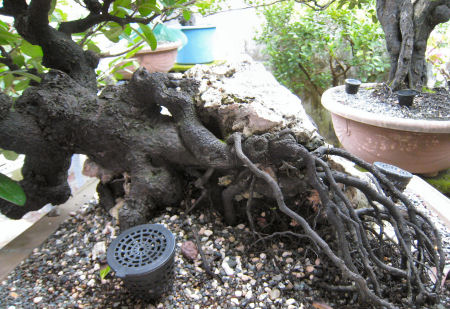trungduart
Administrator
the Bantulinao is a tree species that I am unfamiliar with here in the UK, however, looking through the images in this article, one can appreciate not only the suitability of this species for bonsai, but also the way in which the tree in question has been styled.
This article was first published in the August edition of the Harbest Bonsai Newsletter, an e-mail based newsletter from the Philippines (for more details and subscription information, please see the foot of this page). My thanks go to Leo de Leon and Teddy Lim for granting me permission to reproduce this article at Bonsai4me.com
Bantulinao is a tender evergreen with small white flowers which has red fruits when ripe. It is slow growing and thrives in temperatures of above 15° Celsius. The tree should be positioned in full sun; in warm, wet and windy conditions.


The appealing character of this tree species is that it has uniquely black bark and roots, nice thick ovate leaves, and tiny fruits. The internodes are also naturally short.

Newly sprouted leaves are often red.

Bantulinao flowers in May, bearing fruit in June to July which turn red as they mature.


Amazingly beautiful shari and very aged bark can be found in very old Bantulinao bonsai, just like the ones we see in the pictures above. This is a very desirable characteristic that we try to have in a bonsai. This tree is about a 100 years old.
Cultivation Notes for Bantulinao Bonsai (Maba buxifolia) in the Philippines:
Watering - done twice a day except during summer, when three times a day may be needed. First watering is done early morning and last is late afternoon. Never water your Bantulinao in the evening, may cause disease due to too much dampness.
Soil –Coarse, well draining soil is best. Size of grain is 5 to 10 mm. This will allow good air circulation and water and nutrient retention.
Fertilizer – Organic fertilizer is best.
Pruning and wiring – can be done anytime of the year.
Repotting – Best done in the months of January and February.
Propagation – by seeds
Style – Suitable for all styles
Styling a Bantulinao
This article was first published in the August edition of the Harbest Bonsai Newsletter, an e-mail based newsletter from the Philippines (for more details and subscription information, please see the foot of this page). My thanks go to Leo de Leon and Teddy Lim for granting me permission to reproduce this article at Bonsai4me.com
Bantulinao is a tender evergreen with small white flowers which has red fruits when ripe. It is slow growing and thrives in temperatures of above 15° Celsius. The tree should be positioned in full sun; in warm, wet and windy conditions.


The appealing character of this tree species is that it has uniquely black bark and roots, nice thick ovate leaves, and tiny fruits. The internodes are also naturally short.

Newly sprouted leaves are often red.

Bantulinao flowers in May, bearing fruit in June to July which turn red as they mature.


Amazingly beautiful shari and very aged bark can be found in very old Bantulinao bonsai, just like the ones we see in the pictures above. This is a very desirable characteristic that we try to have in a bonsai. This tree is about a 100 years old.
Cultivation Notes for Bantulinao Bonsai (Maba buxifolia) in the Philippines:
Watering - done twice a day except during summer, when three times a day may be needed. First watering is done early morning and last is late afternoon. Never water your Bantulinao in the evening, may cause disease due to too much dampness.
Soil –Coarse, well draining soil is best. Size of grain is 5 to 10 mm. This will allow good air circulation and water and nutrient retention.
Fertilizer – Organic fertilizer is best.
Pruning and wiring – can be done anytime of the year.
Repotting – Best done in the months of January and February.
Propagation – by seeds
Style – Suitable for all styles
Styling a Bantulinao

















